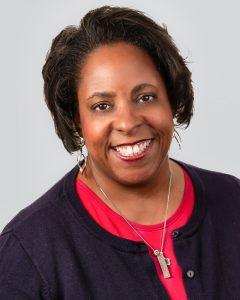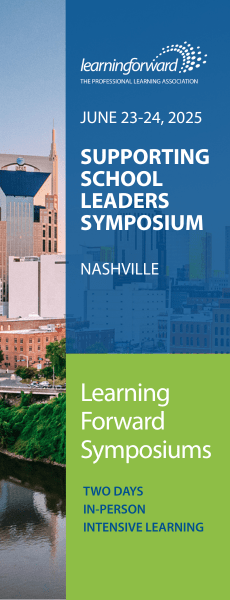6 key features of a successful community of practice
By Michelle Bowman
Categories: Learning communities, Learning designsDecember 2016
Most educators probably know what it feels like to be part of an unproductive professional learning community — one where the topics range from last night’s TV episodes to everyone’s weekend plans before coming around to instructional issues. Other communities might just feel like another staff meeting with a list of announcements. But there are ways to create strong communities of practice that allow schools to address common challenges while also benefitting individual members.
The Redesign PD Community of Practice involves representatives from 21 districts and one charter management organization who are all facing professional learning challenges and working toward solutions that can improve teaching and learning in their districts and across the nation. Facilitated by Learning Forward, the community is also demonstrating how a productive community functions.
Successful communities have six specific characteristics that allow the experience to be rewarding for the members, the students they serve, and the education field in general.
1. Clear focus on a shared problem of practice.
The 22 systems are all working to make professional learning more responsive to teachers’ needs while also looking for the best way to measure whether those professional learning opportunities are improving teachers’ practice.
Without the community, Julie Leopold, director of instructional policy at the New York City Department of Education, says her district probably wouldn’t have had the chance to address those challenges in a meaningful way.
“We’re benefiting from focusing in on a problem that feels potentially very impactful, but that we otherwise wouldn’t have been able to prioritize,” she says. “We are looking forward to hearing from experts on evaluating impact and learning how other districts are tackling this knotty problem.”
While some of the districts are concentrating specifically on measuring the impact of professional learning, others are working to bring more coherence to their systems.
In Georgia’s Fulton County Public Schools, Lydia Conway, executive director for professional learning, says being part of a community of practice “really resonates with us.”
“We are inspired by how this work will improve and further support the district in which we serve,” she says. “This work is challenging us to work smarter and take risks in new directions.”
2. Active learning through process of inquiry.
The district teams are following an ongoing cycle that begins with assessing their current state in relation to the milestones they want to reach, gathering information on how to close gaps between their current state and the milestones, planning detailed actions how to reach those goals, and implementing those actions and gathering data on what worked and what didn’t.
By the middle of 2017, when the community completes its work, the teams are expected to repeat the cycle several times.
3. Collective ownership.
Each team member has a role in working through the cycle and testing out ideas as teams design professional learning for teachers and improve structures already in place.
The Community Advisory Board, a governance structure intended to contribute to community decisions, describes collective ownership across three levels. The advisory board is responsible for holding the community accountable to agreed-upon benchmarks and timelines. The board also models authentic involvement for other members of the community. The hub, which is Learning Forward, is obligated to share clear expectations and effectively facilitate the community, while each individual system does the work back in its district and regularly communicates progress.
4. Appropriate mix of partners.
Each district team includes representatives who can bring different perspectives to the problem and to finding solutions, such as district-level officials, a teacher, a principal, or an instructional coach. In their different positions, they can help communicate to peers about changes and new opportunities for professional learning.
The various perspectives on the team help to ensure the work remains true to established goals and reaches agreed-upon milestones. Participation by senior members of the district leadership team can protect those committed to the work from being pulled to other “urgent needs.”
5. Sufficient commitment to support implementation.
In addition to meeting together in their districts, teams come together periodically for dedicated “team time” and to learn from each other. These gatherings allow team members to see how other districts in the community approach the same issues. In an activity called “targeted networking,” districts present their overall plan and what they’ve implemented so far while members of the other teams ask questions.
Leopold says she found the format “to be a very helpful way to zoom in on key work and challenges of our own as well as of other districts.”
But the teams are also sharing what they are learning outside of official gatherings.
“We’ve found the informal conversations we have with districts to surprisingly be the most rewarding,” Conway says. “One statement or thought during a conversation will lead to the most intriguing connections and dialogue around an issue our district is having.”
6. An effective structure of governance and decision making.
Each team has an executive sponsor — a high-level administrator in the district or charter management organization who can provide support and make sure team members get the time and resources they need to design and implement their plans.
Ultimately, as school systems in the community share ideas with each other and more broadly, the districts will provide examples for the nation on how to improve professional learning for teachers.
For instance, Marna Messer, an assistant director in Jefferson County Public Schools in Colorado and project administrator of the district’s Innovative Professional Development initiative, says her team shared information about Jefferson County’s summer learning institute with the team from Fulton County Public Schools in Georgia. In return, they are learning about Fulton’s personalized learning initiative. Jefferson County team members are also hoping to spread what they’re learning across their state.
“We’re working with Denver to share our work with measuring impact,” Messer says, “so that we can think about how we can support each other and help influence other districts in Colorado.”
Conway agrees that being part of a community of practice is not only about sharing what each district has done — it’s about being open to learn from each other and push toward new solutions. Her team has also set up conference calls with other teams so they can dive into the details of how the districts are approaching the problem.
“Hearing how others have navigated through similar waters has challenged our own assumptions,” she says, “and really changed the course of action we were taking in some instances.”

Michelle A. Bowman is senior vice president of networks and continuous improvement at Learning Forward. She engages in and executes cross-organizational strategic thinking, especially through the strategy of networks and communities of practice, that supports state and local education agencies committed to professional development redesign. She also oversees the development of content and learning designs that support organizations' capacity to engage in continuous improvement processes. With 30 years in public education, Michelle served in leadership at the district, campus, and classroom levels before joining Learning Forward. Michelle has an Ed.D. in Learning and Organizational Change from Baylor University. Her dissertation investigated how school district leaders engaging in a community of practice impacts their professional learning efficacy. She also co-authored Teacher Professional Development in the Digital Age: Design and Implementation of Learning without Limits in Technology in the Classroom: How It Can Improve Teaching and Student Learning in American Schools (Rowman & Littlefield, 2017) with Learning Forward Executive Director (retired) Stephanie Hirsh. Michelle refreshes her soul, mind, and body by singing songs of worship and spending time with family and friends. She enjoys great coffee and long walks.
Categories: Learning communities, Learning designs
Recent Issues
LEARNING DESIGNS
February 2025
How we learn influences what we learn. This issue shares essential...
BUILDING BRIDGES
December 2024
Students benefit when educators bridge the continuum of professional...
CURRICULUM-BASED PROFESSIONAL LEARNING
October 2024
High-quality curriculum requires skilled educators to put it into...
LEARNING TO PIVOT
August 2024
Sometimes new information and situations call for major change. This issue...









